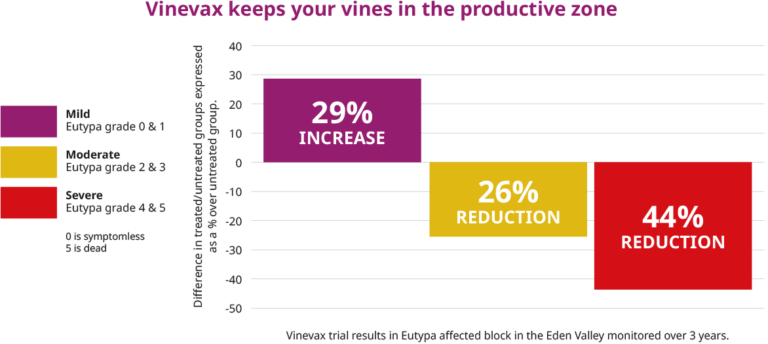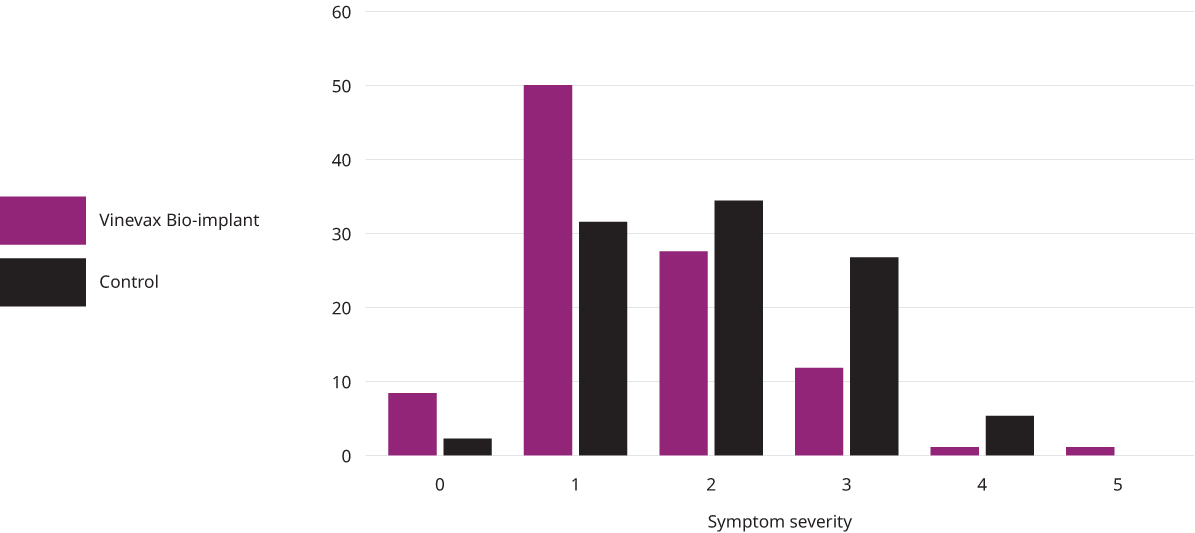Vinevax Biological Fungicide Bio-Implants are a cost effective long term treatment for your vines.
Each Bio-Implant contains proprietary Trichoderma strains formulated as a slow-release implant for the prevention and treatment of diseases caused by wood-invading trunk pathogens in grapevines and fruit trees.
Vinevax Biological Fungicide Bio-Implants are registered for activity against Eutypa lata.
Protection of healthy vines
Drill a hole at a slight upward angle 28mm deep x 6mm diameter into the trunk below the cordon and insert one Bio-implant.
Treatment of diseased vines
For mild disease which only affects the cordon: Drill the hole into clean trunk wood below the cordon and insert 1 Bio-implant. Cut-off affected cordon wood.
For severe disease which has spread into the main trunk
Drill the hole into clean wood as close as possible to ground level or 25 to 50mm below the position of a water shoot suitable for reconstruction of the vine.
Apply 1 Bio-implant per vine.
Tips for Use
Avoid treatment during sap flow in late winter/early spring.
Detailed technical specifications, application instructions and safety information can be found in the following documents:

What is it and how does it work?
What is it?
Vinevax Biological Fungicide Bio-Implants are a small wooden dowel inoculated with Trichoderma spores. Only 25mm long and 6mm wide, they are inserted into the trunk of the vine and tapped flush with the bark, The dowel is in contact with the vascular system where the spores migrate and colonise around the site. Over time the bark regrows over the site and encapsulates the implant.
How does it work?
Vinevax Biological Fungicide Bio-Implants have been shown to colonise around the parenchyma cells of the vine pith where they inoculate the grapevine tissue and stimulate the natural defense mechanisms throughout vine.
This produces a “vaccination” effect that enables the vine to become more resistant to, and better able to cope with, disease and divert its energy into grape production.
Vinevax Biological Fungicide Bio-Implants protect vines from infection by pathogens causing vascular trunk diseases such as Eutypa die-back that lead to production losses and eventual vine death.
Numerous case studies have proven the cost benefit of bio-dowels. Application of the dowel reduces the expression of vascular trunk diseases and this improves vine health, longevity and productivity ensuring that your investment will be paid back many times over. Apply once to to protect vines for at least 5 years.
Vinevax Biological Fungicide Bio-Implants are ACO registered and have no MRL’s or withholding periods.
Key Features
May assist in the control of Eutypa dieback.
Cost effective application
5+ years of Trunk Disease Protection
No Residues or Withholding Periods
Trial Results
The true cost of Eutypa Dieback
Eutypa dieback, caused by the fungus Eutypa lata, is a major disease of grapevines worldwide and causes considerable economic loss to the wine industry.
The fungus infects exposed pruning wounds, colonising the cordons and trunk resulting in stunted shoots and disfigured and uneven bunches and eventually death of the vine.
Once established in vines, the only method of controlling Eutypa dieback is through the removal of all infected wood tissue using remedial surgery.
In 1999, Trevor Wicks reported yield losses in Shiraz vineyards could be up to 1500kg/ha which might conservatively be valued at $3000 NZD.
Vinevax Biological Fungicide Bio-Implants can be used at all stages of disease expression.

Increased vine vigour
In multiple trials conducted at major Australian vineyards consistent yield benefits were measured. In these trials, a single dowel was used per vine and the vines were assessed over a period of 3 years.
At Taylors, 30 vines were assessed from each of 6 rows and compared to control rows. Treated vines showed an increase in the number of bunches per vine and in the weight of these bunches.
This led to a corresponding increase in yields in the sampled vines and indeed in the whole trial area. This trend was replicated at Kaesler and Henschke as you can see in the graph below. All the data in these trials was collected by the vineyards.
Yield was at least 20% higher in treated rather than in the untreated vines.

Untreated on the left, treated on the right.
Vinevax Bio-dowel® improves vine vigour.
% increase in yield/vine two years after treatment

Grapevine health after re-working vine
In cases of severe Eutypa dieback, it can be necessary to remove the original trunk to eliminate all infected tissue. A single Vinevax Bio-Implant, placed at the base of a watershoot trained up to form a new canopy, protects the new growth.
This method limits any loss of production through the reconstruction process.
In a trial in the Hawkes Bay, dowels were used in 500 vines requiring reconstruction. Treated vines also had the cut wood painted with Vinevax Wound dressing.
Four years later, the health of reconstructed vines was graded on a scale of 0 to 3, clear of symptoms (0), right through to yellowing or stunting and finally death (3).
The benefits of using the dowel were clear at this point.
96% of treated vines were found to still be clear of disease and this compared to only 10% of vines in the untreated areas.

% of vines

Symptom reduction
In mild cases of Eutypa dieback (i.e., no trunk removal), Vinevax Biological Fungicide Bio-Implants can still be applied to maintain vine health and profitable yields.
In multiple trials in the Eden Valley, symptomatic vines were graded for disease severity on a scale of 0 to 5, which ranged from from healthy to dead.
Vines treated with Vinevax were more likely to stay within grades 0 or 1, which were grades rated by Trevor Wicks to be the “economically productive” zone.
Assessments were made for four years and whilst you could not say that Vinevax removed all evidence of disease, the trend was for the treated vines to show a much slower deterioration over time.
Use Vinevax to keep your vines in the productive zone.

% of vines

